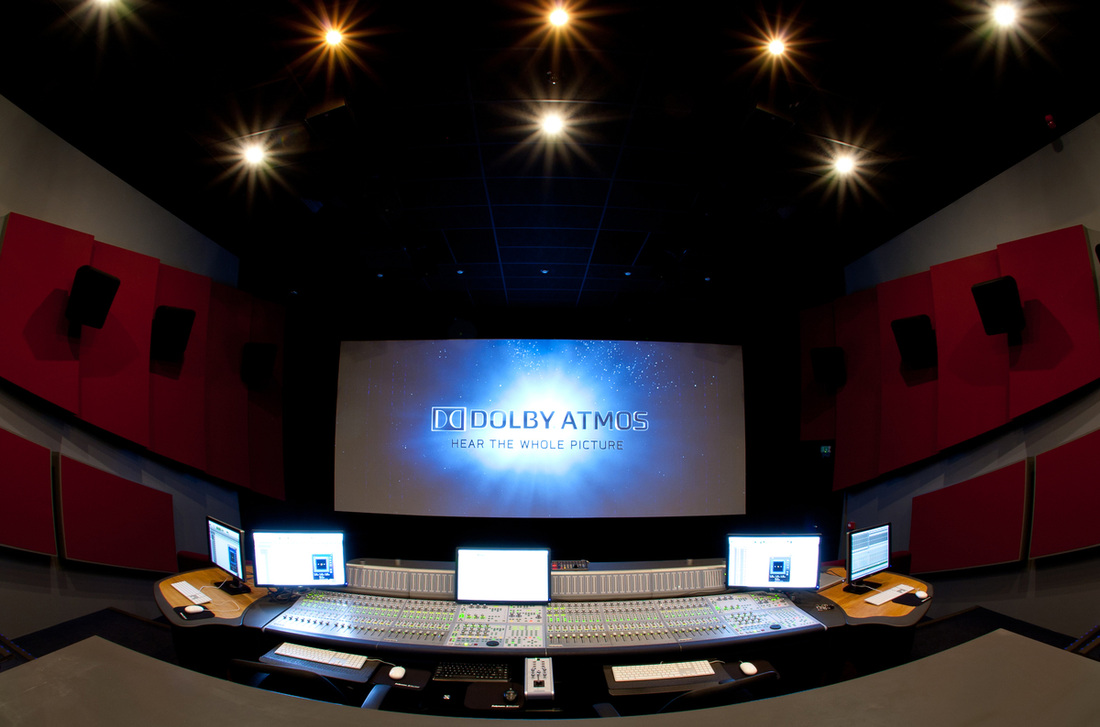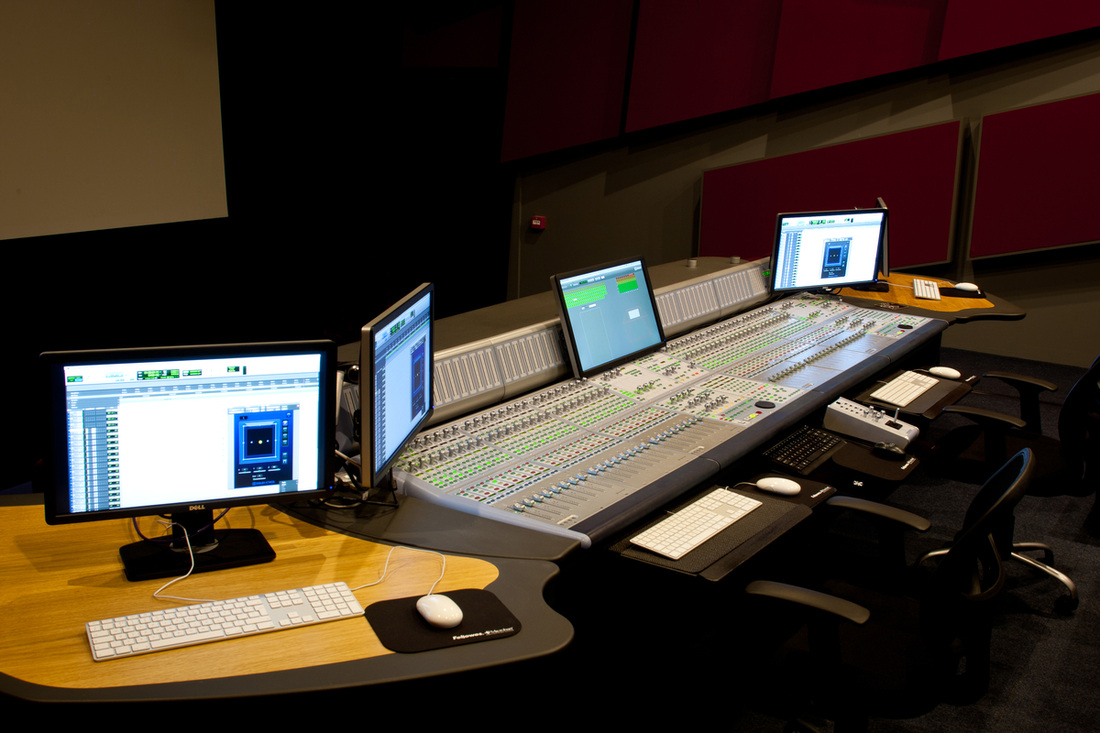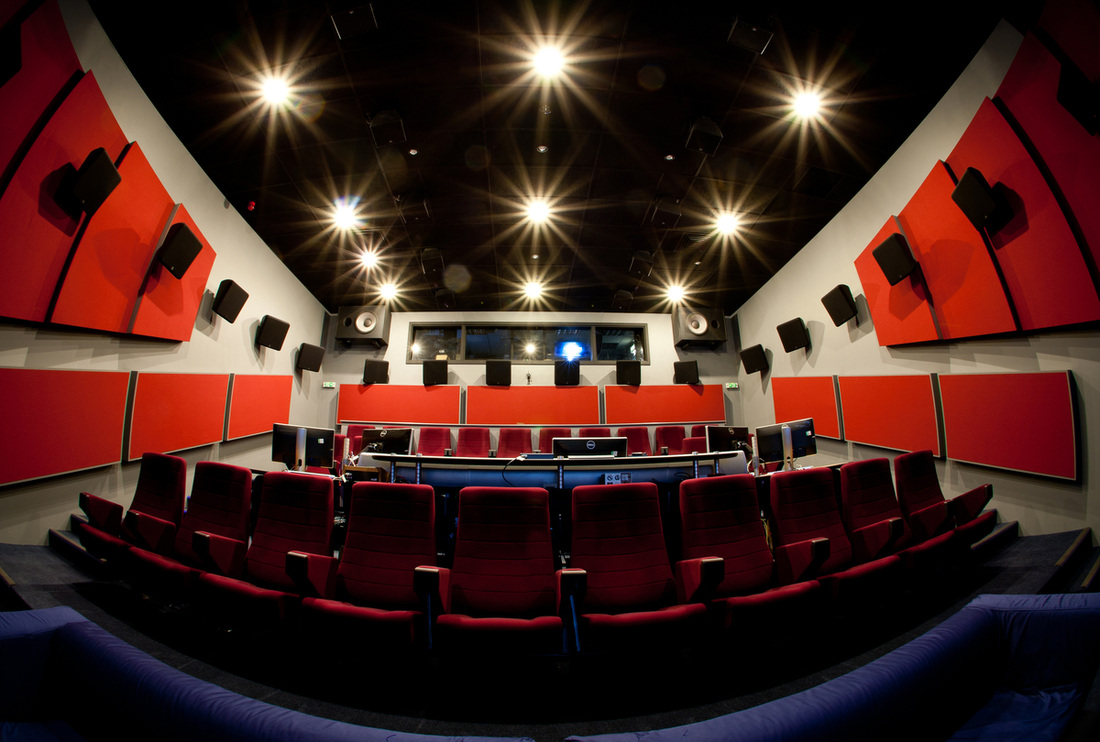Adam Daniels of 'Point1Post' based just five minutes from Elstree Studios, kindly takes the time to talk to us about the new Dolby Atmos suite that they have recently installed, and how it changes the potential for cinema sound (frequently referred to as '3D sound').
Currently the number of cinemas housed with the Dolby Atmos sound system are limited – what prompted your decision to install the 45 speaker set up for the Dolby Atmos studio this point?
Adam:
Dolby Atmos was introduced in 2012. In just two years every major Hollywood post production facility has installed an Atmos system. These companies include Warner Bros, Fox, Sony and Technicolor on the Paramount Lot. Last year eight out of the top ten biggest grossing films at the US box office were mixed in Dolby Atmos. It is shaping up to look like a similar story this year. The number of cinema screens that offer Dolby Atmos is increasing on a weekly basis. The timing was right to become part of the next chapter in film mixing.
How have your clients been responding so far when viewing the studio?
Adam:
It is fair to say that every client who has experienced Dolby Atmos in our room has been blown away by the potential. Sound supervisors, editors, directors and producers have all become very excited by the new creative possibilities available to them. They love the immersive feel and how smooth the panning is. It is the discrete speaker outputs and full range surrounds that make this possible.
From a mixing point of view, is mixing for Dolby Atmos significantly different to mixing for 7.1 or 5.1. Is there a different style incorporated?
Adam:
The workflow that Dolby has created for Atmos is fantastic. It completely integrates with the industry standard Pro Tools platform. You mix the film just as you would any 7.1 or 5.1 project. The only difference is that you can now pan sounds in the x,y and z axis using the Dolby Atmos panner plug-in. Traditional 5.1 created the sense of movement by raising and lowering the sound on each wall of the theatre. In Atmos each speaker is individually fed from the processor rather than being part of an array. The addition of speakers on the ceiling literally puts you in a dome of sound. There are 118 sound objects available to individually pan through the x,y,z space. The mixing potential is huge!!!
In your view, is there a particular genre of film that stands out as being particularly suited for a Dolby Atmos mix?
Adam:
Dolby Atmos is suitable for every genre of film. I think with time that subtle details will become just as valued as the more obvious FX driven applications. A scene in a busy market could have you surrounded by chatter and a sense of movement as the crowd stroll by. In a horror film the sound of somebody walking on the creaky floorboards overhead could be genuinely creepy. Another example could be a couple having a romantic stroll in the woods. You could hear the branches move, the wind blowing the leaves and individual birds tweeting all around you. Quite simply Dolby Atmos takes the cinematic experience to the next level.
As a sound mixer, what has been the toughest challenge with providing a Dolby Atmos mix?
Adam:
Delivering a Dolby Atmos mix just involves good communication with the sound crew. We spend a couple of hours explaining and demonstrating the workflow if the editors have not used Atmos before. The sound crew can then pre plan which sounds are most likely to be used as objects in the mix. This makes the process very simple. We dedicate a certain number of objects to Dialogue, Music and FX. Pre assigning the objects before the mix streamlines the deliverables process when we generate the masters in various formats for the client.
In your own words, how does the Dolby Atmos mix add to the magic of the cinema experience?
Adam:
Dolby Atmos immerses you in the most natural and lifelike soundfield ever available in the cinema. Unlike the visual 3D formats there is no need for additional headwear. I think it is the best thing to happen since the introduction of Digital Cinema.
Follow Point1Post on twitter: @Point1Post
This blog comes to you in conjunction with @3DtheFuture
Point1Post's Dolby Atmos studio:
Currently the number of cinemas housed with the Dolby Atmos sound system are limited – what prompted your decision to install the 45 speaker set up for the Dolby Atmos studio this point?
Adam:
Dolby Atmos was introduced in 2012. In just two years every major Hollywood post production facility has installed an Atmos system. These companies include Warner Bros, Fox, Sony and Technicolor on the Paramount Lot. Last year eight out of the top ten biggest grossing films at the US box office were mixed in Dolby Atmos. It is shaping up to look like a similar story this year. The number of cinema screens that offer Dolby Atmos is increasing on a weekly basis. The timing was right to become part of the next chapter in film mixing.
How have your clients been responding so far when viewing the studio?
Adam:
It is fair to say that every client who has experienced Dolby Atmos in our room has been blown away by the potential. Sound supervisors, editors, directors and producers have all become very excited by the new creative possibilities available to them. They love the immersive feel and how smooth the panning is. It is the discrete speaker outputs and full range surrounds that make this possible.
From a mixing point of view, is mixing for Dolby Atmos significantly different to mixing for 7.1 or 5.1. Is there a different style incorporated?
Adam:
The workflow that Dolby has created for Atmos is fantastic. It completely integrates with the industry standard Pro Tools platform. You mix the film just as you would any 7.1 or 5.1 project. The only difference is that you can now pan sounds in the x,y and z axis using the Dolby Atmos panner plug-in. Traditional 5.1 created the sense of movement by raising and lowering the sound on each wall of the theatre. In Atmos each speaker is individually fed from the processor rather than being part of an array. The addition of speakers on the ceiling literally puts you in a dome of sound. There are 118 sound objects available to individually pan through the x,y,z space. The mixing potential is huge!!!
In your view, is there a particular genre of film that stands out as being particularly suited for a Dolby Atmos mix?
Adam:
Dolby Atmos is suitable for every genre of film. I think with time that subtle details will become just as valued as the more obvious FX driven applications. A scene in a busy market could have you surrounded by chatter and a sense of movement as the crowd stroll by. In a horror film the sound of somebody walking on the creaky floorboards overhead could be genuinely creepy. Another example could be a couple having a romantic stroll in the woods. You could hear the branches move, the wind blowing the leaves and individual birds tweeting all around you. Quite simply Dolby Atmos takes the cinematic experience to the next level.
As a sound mixer, what has been the toughest challenge with providing a Dolby Atmos mix?
Adam:
Delivering a Dolby Atmos mix just involves good communication with the sound crew. We spend a couple of hours explaining and demonstrating the workflow if the editors have not used Atmos before. The sound crew can then pre plan which sounds are most likely to be used as objects in the mix. This makes the process very simple. We dedicate a certain number of objects to Dialogue, Music and FX. Pre assigning the objects before the mix streamlines the deliverables process when we generate the masters in various formats for the client.
In your own words, how does the Dolby Atmos mix add to the magic of the cinema experience?
Adam:
Dolby Atmos immerses you in the most natural and lifelike soundfield ever available in the cinema. Unlike the visual 3D formats there is no need for additional headwear. I think it is the best thing to happen since the introduction of Digital Cinema.
Follow Point1Post on twitter: @Point1Post
This blog comes to you in conjunction with @3DtheFuture
Point1Post's Dolby Atmos studio:





 RSS Feed
RSS Feed
